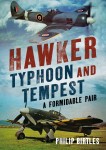Tuesday, November 06, 2018 - 10:28 AM UTC
New from Fonthill Media comes an in-depth study of the Hawker Typhoon and Tempest.
Hawker Typhoon and Tempest - A Formidable Pair
Philip Birtles
Publication: 25 October 2018
Price: £35.00/$50.00
ISBN: 978-1-78155-690-0
Size: 248 x 172 mm
Binding: Hardback
Extent: 288 pages
Illustrations: 222 mono
The Hawker Typhoon and Tempest were unbeatable in the hazardous ground attack role during the Second World War
- The rugged construction of the Typhoon and Tempest helped maintain air superiority during the Second World War
- The Napier Sabre engine provided exceptional power once development problems were cured
- Tempest pilots were able to destroy many V-1 flying bombs and saved civilian lives
- While the Typhoon with its thick wing was ineffective in combat at altitude, the thin wing Tempest excelled
With technology of the Hurricane being at the end of the biplane combat era, there was an urgent requirement for a modern fighter with a capability ahead of anticipated fighter development for the Luftwaffe. Led by Sydney Camm, the Hawker design team created the all-metal stressed skin structure and the Typhoon was powered by the revolutionary Napier Sabre engine. Whereas the Hurricane had been developed in peacetime, the Typhoon was designed during the war, when the urgency of the programme caused the development of both the airframe and engine to be accelerated, resulting in teething troubles not being fully solved when the aircraft entered service with the RAF. The much-improved Tempest used the same engine and basic fuselage with thinner lamina flow wings, giving improved performance at high altitude and allowing the destruction of V-1s. Both aircraft made a significant impact on the victory by the Allies during the Second World War, although their low-level ground attack missions were extremely hazardous and resulted in high losses.
Philip Birtles started work as an engineering apprentice at the de Havilland Aircraft Company in 1957. Following the completion of his training, he was appointed as PA to John Cunningham – the famous Second World War night-fighter ace. Birtles held a number of marketing positions over the remainder of his career in the aerospace industry, taking early retirement when Hatfield Aerodrome finally closed at the end of 1993. He spent over forty years as a trustee of the de Havilland Aircraft Museum and he has written over forty books. His titles for Fonthill Media are De Havilland Mosquito: The Original Multirole Combat Aircraft (2015) and Hawker Hurricane: The Multirole Fighter (2017).
Please remember, when contacting retailers or manufacturers, to mention that you saw their products highlighted here - on AEROSCALE.
Philip Birtles
Publication: 25 October 2018
Price: £35.00/$50.00
ISBN: 978-1-78155-690-0
Size: 248 x 172 mm
Binding: Hardback
Extent: 288 pages
Illustrations: 222 mono
The Hawker Typhoon and Tempest were unbeatable in the hazardous ground attack role during the Second World War
- The rugged construction of the Typhoon and Tempest helped maintain air superiority during the Second World War
- The Napier Sabre engine provided exceptional power once development problems were cured
- Tempest pilots were able to destroy many V-1 flying bombs and saved civilian lives
- While the Typhoon with its thick wing was ineffective in combat at altitude, the thin wing Tempest excelled
With technology of the Hurricane being at the end of the biplane combat era, there was an urgent requirement for a modern fighter with a capability ahead of anticipated fighter development for the Luftwaffe. Led by Sydney Camm, the Hawker design team created the all-metal stressed skin structure and the Typhoon was powered by the revolutionary Napier Sabre engine. Whereas the Hurricane had been developed in peacetime, the Typhoon was designed during the war, when the urgency of the programme caused the development of both the airframe and engine to be accelerated, resulting in teething troubles not being fully solved when the aircraft entered service with the RAF. The much-improved Tempest used the same engine and basic fuselage with thinner lamina flow wings, giving improved performance at high altitude and allowing the destruction of V-1s. Both aircraft made a significant impact on the victory by the Allies during the Second World War, although their low-level ground attack missions were extremely hazardous and resulted in high losses.
Philip Birtles started work as an engineering apprentice at the de Havilland Aircraft Company in 1957. Following the completion of his training, he was appointed as PA to John Cunningham – the famous Second World War night-fighter ace. Birtles held a number of marketing positions over the remainder of his career in the aerospace industry, taking early retirement when Hatfield Aerodrome finally closed at the end of 1993. He spent over forty years as a trustee of the de Havilland Aircraft Museum and he has written over forty books. His titles for Fonthill Media are De Havilland Mosquito: The Original Multirole Combat Aircraft (2015) and Hawker Hurricane: The Multirole Fighter (2017).
Please remember, when contacting retailers or manufacturers, to mention that you saw their products highlighted here - on AEROSCALE.
Click Star to Rate
Only 1 reader has rated this.
THIS STORY HAS BEEN READ 2,403 TIMES.
| Fonthill Media Reviews | MORE |
| Vietnam War Heli Nose Art by Jim Starkweather | |
| History of the Gloster Javelin by Andy Brazier | |
| Thud Pilot by Andy Brazier | of 1 ratings, 100% found this helpful | |
| De Havilland Vampire by Tim Hatton | |
| Britian's Overseas Airlines by Richard Tonge | |
| Soviet Cold War Fighters by Andy Brazier | of 2 ratings, 50% found this helpful | |
| The Avro Manchester by Rowan Baylis | |
| Douglas DC-3 by Frederick Boucher | of 1 ratings, 100% found this helpful | |









Comments